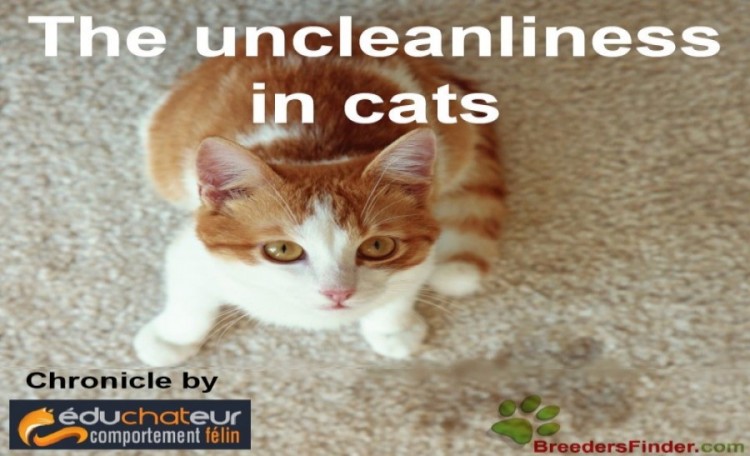
The uncleanliness in cats
- 17 Dec, 2020
- Tips
Out-of-bin eliminations are undoubtedly one of the main disturbing behaviors for cat owners that we, the feline behaviorists, are called upon to solve. Whether it is urine or feces, adopters are often at the end of their patience and desperate, believing that they have tried everything and that it is impossible to solve the problem. They are often very emotional and some will go as far as believing that their cat wants to "get even" or "punish" them for having had it kept during the vacations or for having made a new spouse for example. First and foremost, it is important to get this idea out of your head and accept that the term "revenge" (as well as many other human emotions) does not exist in cats.
Then, in the case of urine, it is important to distinguish between urine marking that is done while standing, tail high in the air that "wiggles" and the jet of urine that is of small volume and sent on a vertical surface VS the puddle of urine of large volume made on a horizontal surface and in a sitting position. These 2 distinct cases of out-of-bin disposal do not have the same causes and therefore do not require the same interventions by the owner. When the cat defecates outside the toilet, there is always a simple reason to explain it:
- the cat has a health problem (whether it is urine or feces),
- the cat is not spayed or neutered,
- the criteria related to the bin and/or everything related to the bin: number of bins, the type of bin (open vs. closed), the size of the bin, the location of the bin, the type of substrate used and the amount put in the bin, the cleaning of the bin, are not suitable (or no longer suitable),
- there are conflicts between cats in the home or with one or more cats outside (even if the cat does not go outside, it may see cats through windows or doors)
So, the first thing to do when your cat urinates or defecates outside the litter box is to consult your veterinarian. This step is essential and can in no way be avoided. If the cat does indeed have a medical problem, it must first be addressed. It is possible that the cat has developed an aversion to the litter box as a result of pain during urination or defecation and that elimination outside the box will continue even after the medical problem has been resolved. If this is the case, the following solutions will solve the problem. In the event that the veterinarian concludes that the cat is healthy, if the cat is not spayed or neutered, it is very likely that the veterinarian will suggest starting with this solution, because in cases of urine out of the litter box, this could be the solution!
Next, you need to examine the tray and the criteria surrounding it:
- The golden rule is: one more tray than the number of cats. The rule of thumb is: one tray more than the number of cats. The trays should not be placed side by side in the same room. Ideally, they should be placed in different rooms and a multi-story house should have one bin per floor.
- The cat should be able to stand diagonally in the tray without its nose and tail tip touching the ends of the tray.
- The bins must be installed in places that are easy to access, not very crowded, but still frequented by the cat. Avoid closets, closets, engine rooms, long dark hallways, cramped areas. Do not place bins near food and water bowls.
- The substrate used must be soft and comfortable. The clumping substrate is generally the most popular with cats. Do not be frugal about the amount of substrate used. The cat must be able to dig and bury its needs easily. 2-3 inches usually do the trick. Avoid scented substrates, deodorizers and air fresheners near the bins.
- Collect feces in the bins every day, once or twice a day depending on the number of cats. Thoroughly clean the bins with warm water and dish soap about once a month.
- An open or closed bin can be used as long as all the other criteria above are respected. Avoid self-cleaning litter boxes and toilet training kits at all costs.
- Finally, in cases of urinary marking, if the reason identified is anxiety related to conflicts between cats in the home, consult an intervener to help implement modifications and resolve altercations. If the cat goes outside and quarrels with other cats, he should not go anymore. If the cat sees cats outside through the windows and reacts strongly to them, privacy films can be installed at cat eye level in the problematic windows.
In conclusion, one must be patient and proceed step by step to determine what the cat likes or dislikes. Once found, it's done!
By Educhateur
Éduchateur is a team of feline behaviourists referred by more than 250 veterinary clinics in Canada and France since 2007. Every year, they help thousands of adopters to solve feline behaviour problems and understand their cats' needs in order to live in harmony with them.









